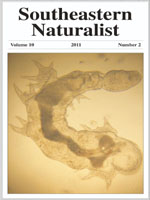The eastern population trend of Passerina ciris (Painted Bunting) declined 3.5% annually during the first 30 yrs of the Breeding Bird Survey (BBS, 1966–1996). Recently, the US Fish and Wildlife Service listed Painted Buntings as a focal species. Surveys for this focal species for the next 10 yrs (BBS, 1997–2007), however, are too low (<1 bird per 50 stops) for determining trend estimates. Also, to monitor densities adequately, surveys should account for incomplete detections. I surveyed singing Painted Buntings from 13 May to 26 June 2003 at 582 point counts (50 randomly selected transects) within blocks (64 × 64 km) in coastal and river areas from Florida to North Carolina. I compared densities of Painted Buntings for major habitats. Painted Buntings were detected at 33.5% of points surveyed for 5 min. Densities varied from 9 singing males per km2 in young pine plantations to 42 per km2 in maritime shrub. Effective detection radii for habitats varied from 64 to 90 m and were slightly higher in developed than in undeveloped habitats. Distance sampling is recommended to determine densities of Painted Buntings; however, large sample sizes (70–100 detections/habitat type) are required to monitor Painted Bunting densities in most habitats in the Atlantic coastal region of the southeastern United States. Special attention should be given to maritime shrub habitats, which may be important to maintaining the Painted Bunting population in the southeastern US.
How to translate text using browser tools
1 June 2011
Population Densities of Painted Buntings in the Southeastern United States
J. Michael Meyers
ACCESS THE FULL ARTICLE

Southeastern Naturalist
Vol. 10 • No. 2
June 2011
Vol. 10 • No. 2
June 2011




